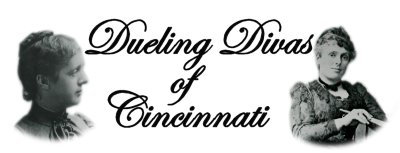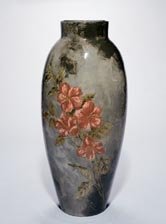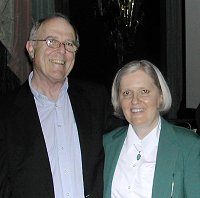Thursday, April 21, 2005
Ellis Rocks AAPA Banquet With:

L to R, McLaughlin and Longworth Nichols Storer
The time-silvered image of Rookwood Pottery founder and 19th century Cincinnati, Ohio socialite Maria Longworth Nichols Storer took on a little realistic tarnish last evening during a fascinating lecture presented to the assembled members of the American Art Pottery Association by Anita Ellis, author, Cincinnati art pottery expert and Curator of Decorative Arts at the Cincinnati Art Museum.
Entitled the “Dueling Divas of Cincinnati Ceramics” Ms. Ellis, through slides and her own impeccable research, enthralled attendees of the 25th annual AAPA convention with the “sometimes bitter” relationship between the spoiled, immeasurably wealthy and artistically challenged Maria Longworth and skilled portrait painter Mary Louise McLaughlin, a middle class Cincinnati woman who first perfected the under glaze slip painting technique sought by world ceramicists for thousands of years.

McLaughlin's Ali Baba vase
Ellis described escalating tensions that began with Longworth’s petty jealousy of McLaughlin’s more skilled artistry and heightened as the middle class woman’s reputation and skill outpaced Maria’s family buying power and her own “vivacious…rashness”.
Indeed, Ellis made a convincing case that Longworth’s celebrated pottery accomplishments were largely motivated not by an artistic muse but rather by a base desire “not to be upstaged by an insignificant merchants' daughter.”
Savvy readers of the limited Rookwood and Cincinnati art pottery source material available to the general public have long suspected more to the seemingly sanitized storylines wafting about the very politically well-connected Longworths.
Ellis offered her postprandial listeners a few chunks of raw historical meat.
--Maria’s first marriage, described as “tempestuous”, to Colonel George Ward Nichols ended on September 15, 1885 when the Colonel died following several years battling tuberculosis.
Maria scandalized Cincinnati society by openly dating her 2nd husband, politician and later McKinley ambassador, Bellamy Storer throughout the long years of Colonel Nichols’ suffering and then marrying Storer exactly 6 months after the Colonel’s death.
--Regarding Maria Longworth’s legendary lost invitation to McLaughlin’s Pottery Club, Ellis “firmly believes” Longworth “received an invitation” but felt that accepting it would be “acceding to Louise’s [ceramic] supremacy”.
--While Ellis’ book on Mary Louise McLaughlin attributes the christening of her largest ceramic effort, fired in early February of 1880, to Clara Chipman Newton, “Why, Louise, that’s an Ali Baba vase”, Ellis, in last evening’s lecture, stated the name derived from journalistic claims that the 37 ½ inch vase “was big enough to hold some of the 40 Thieves”.
Regardless, the Ali Baba failed to end the tit for tat that saw Maria Longworth fire her smaller 24-½ inch Aladdin vase in the Rookwood pottery’s first kiln in November 1880.
It is reported that within early ceramic history, in a manner remnicent of US history, male anatomy and sport utility vehicles, size indicated progress.
After highlighting a bitter exchange of letters between Longworth and McLaughlin prompted by the Rookwood Pottery’s censorship of a credit to McLaughlin for the discovery of under glaze slip decoration in a catalog for a Rookwood exhibit in Chicago’s 1893 World Columbian Exhibition, Ellis concluded her terrific lecture by saying that without the Longworth-McLaughlin rivalry the history of American Art Pottery, the Rookwood Pottery and under glaze slip painting in general would have progressed along vastly different paths if at all.
In a Q&A that followed the lecture, Ellis discounted any connection between the nascent labor movement plaguing the titans of 1890 era industrial Cincinnati and the Longworth-McLaughlin rivalry.
In another question concerning Laura Fry, the discoverer of the “mouth atomizer” or what became known as the airbrush and a woman who sued the Rookwood Pottery in 1893 for patent infringement, Ellis agreed that Fry received treatment similar to McLaughlin’s from Longworth’s company and that Fry and McLaughlin became “good friends” because of this shared and most undeserved adversity.
My compliments to AAPA’s Patti Bourgeois for orchestrating a convivial evening of scholarship, fun and delicious food in a manner that celebrated the best of the American Art Pottery Association.

Bob Seery with Aniti Ellis at last evening's AAPA banquet
I also greatly enjoyed meeting Cincinnati Art Pottery experts Bob and Mary Ellen Seery from New Mexico last evening.
Bob, who has written some very kind and generous emails regarding this blog, gave further proof of the Seery’s generosity by donating a large Buffalo Pottery Deldare charger to the Cincinnati Art Museum in the name of the AAPA.
In thanking Mr. and Mrs. Seery, Ms. Ellis joked that the piece was “more significant than they perhaps realized” but that the CAM would “keep it”.
I also owe an apology to Mary Ellen Seery and, oddly, myself.
While trying to adjust a photo of myself with Anita Ellis and Mr. and Mrs. Seery, I accidentally cropped and deleted Mrs. Seery and myself from the image.
Scheesch!
Related posts:
March 23, 2003
March 12, 2003
March 10,2003
Images: The Ceramic Career of M. Louise McLaughlin, Cincinnati Art Museum, Wm. Whitford

